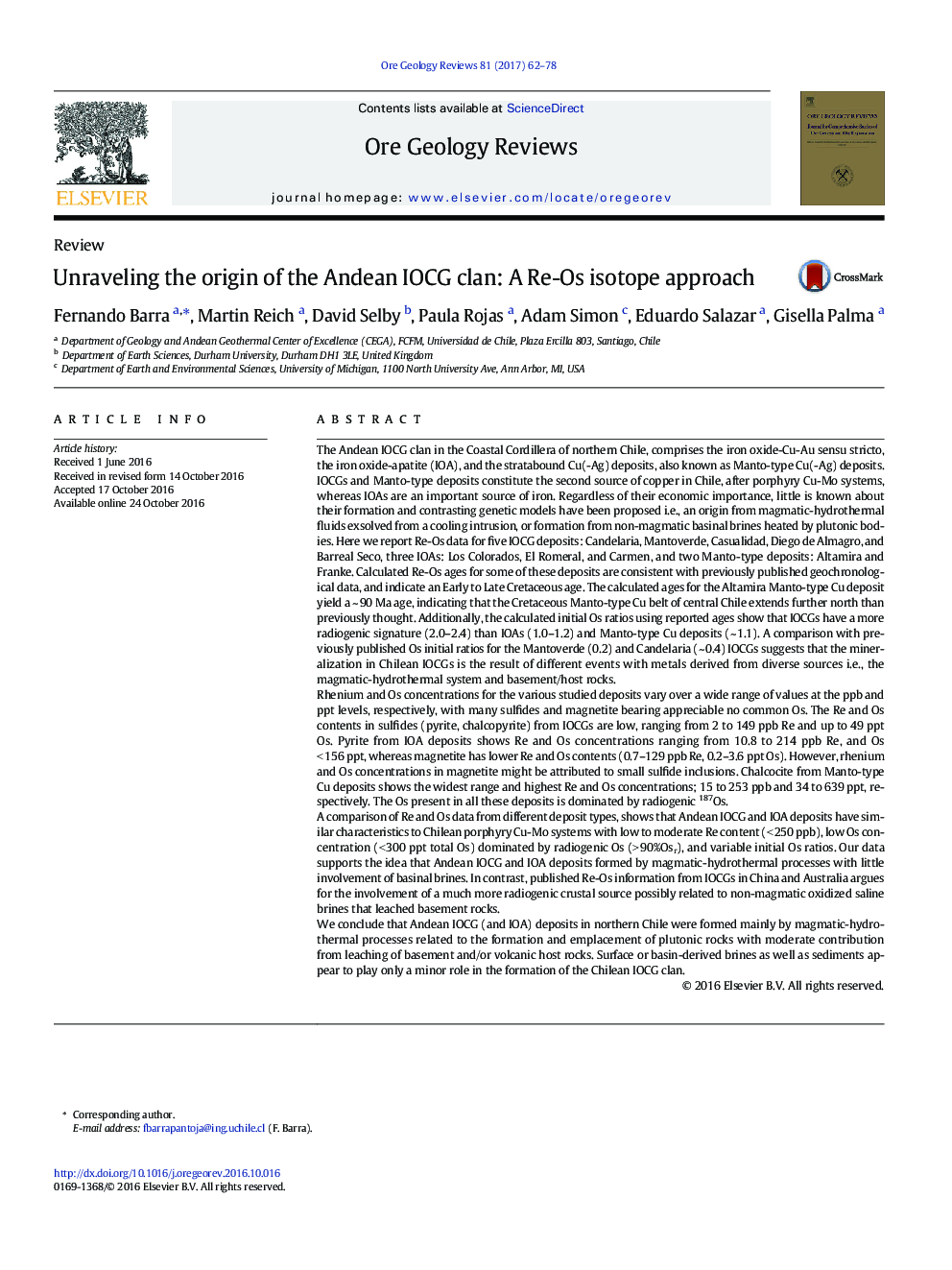| کد مقاله | کد نشریه | سال انتشار | مقاله انگلیسی | نسخه تمام متن |
|---|---|---|---|---|
| 6482033 | 1413928 | 2017 | 17 صفحه PDF | دانلود رایگان |

- We report new Re-Os data for five IOCG deposits, three IOAs, and two Manto-type deposits from the Chilean IOCG clan.
- This new information coupled with previously published Re-Os data is used here to constrain the age of these deposits and provide new insights on the source of metals in the Chilean IOCG clan.
- Re and Os concentrations and initial Os ratios are similar to those reported for Andean porphyry Cu deposits, which suggests that both deposit-types were formed by similar magmatic-hydrothermal processes and that the metals contained in these deposits were derived from crustal sources.
- We conclude that Andean IOCG (and IOA) deposits in northern Chile were formed mainly by magmatic-hydrothermal processes related to the formation and emplacement of magmas with moderate contribution from leaching of basement and/or volcanic host rocks.
The Andean IOCG clan in the Coastal Cordillera of northern Chile, comprises the iron oxide-Cu-Au sensu stricto, the iron oxide-apatite (IOA), and the stratabound Cu(-Ag) deposits, also known as Manto-type Cu(-Ag) deposits. IOCGs and Manto-type deposits constitute the second source of copper in Chile, after porphyry Cu-Mo systems, whereas IOAs are an important source of iron. Regardless of their economic importance, little is known about their formation and contrasting genetic models have been proposed i.e., an origin from magmatic-hydrothermal fluids exsolved from a cooling intrusion, or formation from non-magmatic basinal brines heated by plutonic bodies. Here we report Re-Os data for five IOCG deposits: Candelaria, Mantoverde, Casualidad, Diego de Almagro, and Barreal Seco, three IOAs: Los Colorados, El Romeral, and Carmen, and two Manto-type deposits: Altamira and Franke. Calculated Re-Os ages for some of these deposits are consistent with previously published geochronological data, and indicate an Early to Late Cretaceous age. The calculated ages for the Altamira Manto-type Cu deposit yield a ~Â 90Â Ma age, indicating that the Cretaceous Manto-type Cu belt of central Chile extends further north than previously thought. Additionally, the calculated initial Os ratios using reported ages show that IOCGs have a more radiogenic signature (2.0-2.4) than IOAs (1.0-1.2) and Manto-type Cu deposits (~Â 1.1). A comparison with previously published Os initial ratios for the Mantoverde (0.2) and Candelaria (~Â 0.4) IOCGs suggests that the mineralization in Chilean IOCGs is the result of different events with metals derived from diverse sources i.e., the magmatic-hydrothermal system and basement/host rocks.Rhenium and Os concentrations for the various studied deposits vary over a wide range of values at the ppb and ppt levels, respectively, with many sulfides and magnetite bearing appreciable no common Os. The Re and Os contents in sulfides (pyrite, chalcopyrite) from IOCGs are low, ranging from 2 to 149Â ppb Re and up to 49Â ppt Os. Pyrite from IOA deposits shows Re and Os concentrations ranging from 10.8 to 214Â ppb Re, and Os <Â 156Â ppt, whereas magnetite has lower Re and Os contents (0.7-129Â ppb Re, 0.2-3.6Â ppt Os). However, rhenium and Os concentrations in magnetite might be attributed to small sulfide inclusions. Chalcocite from Manto-type Cu deposits shows the widest range and highest Re and Os concentrations; 15 to 253Â ppb and 34 to 639Â ppt, respectively. The Os present in all these deposits is dominated by radiogenic 187Os.A comparison of Re and Os data from different deposit types, shows that Andean IOCG and IOA deposits have similar characteristics to Chilean porphyry Cu-Mo systems with low to moderate Re content (<Â 250Â ppb), low Os concentration (<Â 300Â ppt total Os) dominated by radiogenic Os (>Â 90%Osr), and variable initial Os ratios. Our data supports the idea that Andean IOCG and IOA deposits formed by magmatic-hydrothermal processes with little involvement of basinal brines. In contrast, published Re-Os information from IOCGs in China and Australia argues for the involvement of a much more radiogenic crustal source possibly related to non-magmatic oxidized saline brines that leached basement rocks.We conclude that Andean IOCG (and IOA) deposits in northern Chile were formed mainly by magmatic-hydrothermal processes related to the formation and emplacement of plutonic rocks with moderate contribution from leaching of basement and/or volcanic host rocks. Surface or basin-derived brines as well as sediments appear to play only a minor role in the formation of the Chilean IOCG clan.
Journal: Ore Geology Reviews - Volume 81, Part 1, March 2017, Pages 62-78